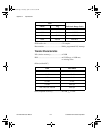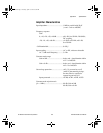
Chapter 6 Theory of Analog Operation
©
National Instruments Corporation 6-9 PCI-4451/4452 User Manual
The resulting output of the filter is a band-limited signal with a dynamic
range of over 90 dB. One of the advantages of a delta-sigma ADC is that it
uses a 1-bit DAC as an internal reference, whereas most 16-bit ADCs use
16-bit resistor-network DACs or capacitor-network DACs. As a result, the
delta-sigma ADC is free from the kind of differential nonlinearity (DNL)
that is inherent in most high-resolution ADCs. This lack of DNL is
especially beneficial when the ADC is converting low-level signals, in
which noise and distortion are directly affected by converter DNL.
Noise
The PCI-4451/4452 analog inputs typically have a dynamic range of more
than 90 dB. The dynamic range of a circuit is the ratio of the magnitudes of
the largest signal the circuit can carry and the residual noise in the absence
of a signal. In a 16-bit system, the largest signal is taken to be a full-scale
sine wave that peaks at the codes +32,767 and −32,768. Such a sine wave
has an rms magnitude of 32,768/1.414 = 23,170.475 least significant bits
(LSBs).
A grounded channel of the PCI-4451/4452 has a noise level of about
0.65 LSB rms (this amount fluctuates). The ratio of 23,170.475 / 0.65 is
about 35647, or 91.0 dB—the dynamic range. Several factors can degrade
the noise performance of the inputs.
First, noise can be picked up from nearby electronics. The PCI-4451/4452
works best when it is kept as far away as possible from other plug-in
devices, power supplies, disk drives, and computer monitors. Cabling is
also critical. Make sure to use well-shielded coaxial or balanced cables for
all connections, and route the cables away from sources of interference
such as computer monitors, switching power supplies, and fluorescent
lights.
Finally, choose the sample rate carefully. Take advantage of the antialias
filtering that removes signals beyond the band of interest. Computer
monitor noise, for example, typically occurs at frequencies between
15 and 50 kHz. If the signal of interest is restricted to below 10 kHz, for
example, the antialias filters reject the monitor noise outside the frequency
band of interest. The frequency response inside the band of interest is not
influenced if the sample rate were between roughly 21.6 and 28 kS/s.
User.book Page 9 Tuesday, April 14, 1998 10:20 AM


















